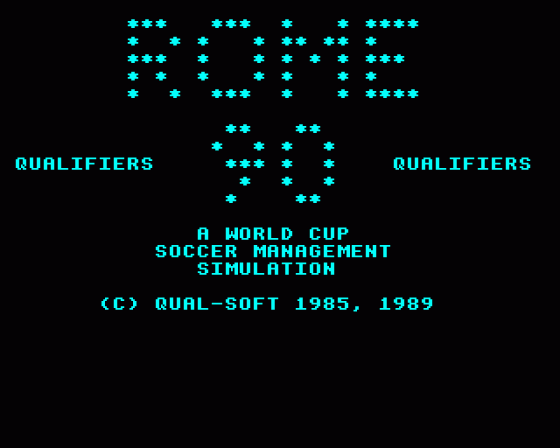
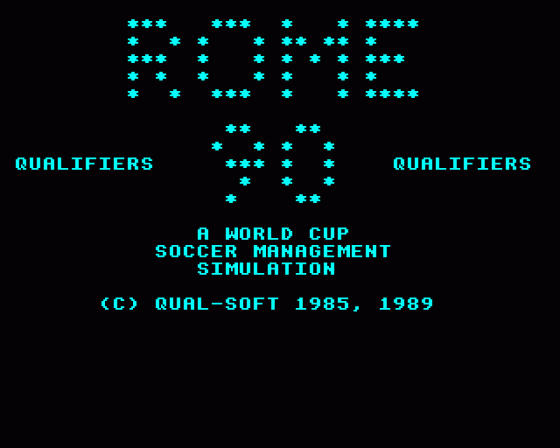

| Genre: | Strategy; Football Management Simulation; Text Onl |
| Publisher: | Qualsoft |
| Cover Art Language: | English |
| Machine Compatibility: | BBC Model B, BBC Model B+, BBC Master 128, Acorn Electron |
| Release: | Professionally released on 2 x Cassette |
| Available For: | BBC/Electron |
| Compatible Emulators: | BeebEm (PC (Windows)) PcBBC (PC (MS-DOS)) Model B Emulator (PC (Windows)) Elkulator 1.0 (PC (Windows)) |
| Original Release Date: | 1st January 1984 |
| Original Release Price: | £12.99 |
| Market Valuation: | £9.27 (How Is This Calculated?) |
| Item Weight: | 98g |
| Box Type: | Cassette Double Plastic Clear |
| Author(s): | Malcolm Howard & Malcolm Harwood |
Variant Items
There are 0 other items featuring this same game (that we know about!). Click any of them for their details.
Active Auctions
Closed Auctions
Buy It
Unfortunately no-one is currently selling this item.
Auction Price Watch
Worried you're being ripped off? Closing prices on eBay can help you decide what a reasonable price is for a particular item.
Full Instructions
Introduction
In the summer of 1990, in Rome, we will see the culmination of two years of the most prestigious soccer competition, last held in 1986. Something approaching 100 international football sides will fight it out over those two years so that they can be there, in that cauldron of a stadium, to determine the world champions for the next four years. Italy will be a festival of football. For many young fans, the first time they have seen the World Cup finals, and for many older English fans the memory of Wembley in 1966, the brilliant match against Portugal and the agonising final against West Germany, will whet the appetites for Rome 1990.
For six years no, QualSoft have developed the art of soccer management simulation in the field of club football, and to celebrate the 1989/1990 World Cup year, have applied the many lessons learned from those years to produce a game to simulate the unique nature of international team management in the context of the World Cup.
The game has been split into two parts; the World Cup qualifiers and the Finals as they will be played out in Italy. In the qualifiers we have stuck to England’s qualifying group, along with a few friendly matches some of which the England team actually played just before the qualifiers began: Denmark at Wembley and Greece in Athens. We have included a South American tour against Brazil, Uruguay and Chile. We have taken advantage of the unknown aspects of the finals by following their structure, but by providing our own draw which will produce a different path to the final each time you play the game.
It’s worth mentioning here that the FA have informed us of changes in the finals that have been included in the game. The preliminary part of the final tournament will be six leagues of four with the top two from each league, and the best four losers, going forward into a 16 team knockout competition. Another important change is that only 20 players will be allowed for each squad, but all of these players, injuries permitting, will be available for the match. Eleven players will of course take the field, but the two substitutions will be allowed from the remaining nine players, not just five named players as in the past World Cups. These changes have been introduced into the Finals tape.
Since Alf Ramsey provided the importance of intelligent management in international football, we have had, as England manager, a sequence of successful club managers who have failed to make the grade at international level. There is, of course, a much more severe demand on the international manager to judge the exact abilities of players and how those abilities will blend together to form a successful team. At club level, a manager has the opportunity to work with his players six days a week, week in week out, for a whole season, and can slowly build up the teamwork so necessary for success. At international level, he will get his players together for perhaps three days before a match, perhaps a dozen times per season. There just isn’t the opportunity to force a blend into the side. A successful blend must be visualised by the manager based on his reading of the individual player abilities. It takes judgement and imagination to, first, choose a team, and then make an accurate assessment of players, and the effectiveness of combinations of players, during the match.
In ROME 90, we have tried to simulate these requirements. You’re looking for a good blend of in-form players; the problem for you, as manager, is to quickly determine the form of the players, and, as you experiment with your team, to constantly keep in mind the blend of abilities of your team selections. Dropping an out of form player from your team will often mean, not just providing a direct replacement, but re-arranging the team because the abilities of your replacement player do not match those of the dropped one. A couple of key injuries which force you to replace players can literally send you ‘back to the drawing board’.
ROME 90 is a game that simulates international football management, in the setting of the 1990 World Cup. It’s a game in which we have tried to combine the fun and pleasure of the game of football and with its most important competition, while simultaneously providing a real challenge to your knowledge of the game. You will find a wide (60 in all) variety of ‘levels’ to supply the particular combination that suits you. The true ‘level’ choice will affect the quality of the sides you will have to beat, while the other choices will complicate the game in one way or another.
Choose the level, sophistication and complications of the game that best suits you, and good luck!
Setting The Scene
In the summer of 1988, England took part in the European Championships in West Germany and gave a miserable performance with three straight losses. The performance of England in international competitions over many years now has left a lot to be desired. We must go back to 1970 before we look at an England team that had a genuine chance of winning the competition. It’s ironic that it was only the loss of players through injury and suspension in Mexico ’86 that forced the England manager into fielding a team that began to win. With the ban of English clubs from European competition, English football is at its lowest ebb.
But there’s hope! The current England manager has resigned and you have been chosen to lead the England team into the World Cup qualifiers that will begin this autumn.
You now have to put together some sort of team to take on the Danes at Wembley. No-one will blame you if you scrap the entire squad and begin from scratch with your own choices, your own ideas... at least for the moment they won’t. However, if you fail to take England to the World Cup finals with your own squad and ideas, then you’ll quickly find out how easily the press and public will allocate blame.
This summer will give you a real opportunity to give your ideas a stern trial with a match in Athens against the Greeks, followed by a trip to South America to play Brazil, Uruguay and Chile within the space of one week. It will be up to you to put together the beginnings of a world-beating squad during these friendlies, because from then on the pressure is on with the World Cup qualifiers beginning.
You haven’t been given a difficult qualification group, the top team will automatically qualify and two of the second teams from the three four-team groups also. Eight points should do it. But with only six games to play, you cannot afford to make many mistakes. You will also need to continue to experiment if you are to produce a squad to beat the very best in the World. In the finals there is no place to hide.
Should you succeed in qualifying, and if you don’t you’re guaranteed the boot, then you will need to take your best squad of 20 players to Italy.
Eleven players never made a team, particularly when matches at the Finals will sometimes be separated by only two days, and when the opposition will put out teams with formations varying from a 5 man defence /sweeper formation to attacking 4-2-4 combinations. With two substitutes allowed from your remaining nine players then the possibilities for effective tactical substitutions is enormous. So you will want twenty good players, not eleven.
The draw for the “league of four” preliminaries has something of a Wimbledon style “fix” about it, with seeds and qualification group winners being distributed evenly throughout the groups. This means that as a winner of your qualifying group you will have an easier time than as a second place qualifier; a group being made up of a seed, a group winner, a second level qualifier and a minnow (Morocco, Canada, etc...if you’re lucky). As a qualifier in second place you will have a seed and a group winner to contend with, but as a group winner, only a seed and a second level qualifier. As the two top teams in this league will automatically qualify for the last sixteen, while the third team will have to “sit it out” and see if it is a “best loser”. It’s obviously an advantage to have a less able team, along with the seed, as your main competition.
From here on it is no mistakes at all! From here on you have to win everything! It may take extra time, it may even take a penalty shoot-out, but you must win! Failure to do so means you’re out. From here on, it’s the last sixteen, the Quarter Finals, the Semi Finals and the Final. All must be won if you are to become World Cup Champions for 1990-1994.
The remainder of the manual: At this point it is worth commenting that the game can be played without ploughing your way through the rest of the manual. It is probably best to get some idea of the program by playing the game, and merely refer to the rest if you meet any particular difficulty. When you come to play the game at the highest levels, it will benefit you to go through the remaining pages to obtain best results, but at this first time of reading, the full 20 pages will become a little indigestible, for youngsters even intimidating, merely because describing in writing is often much more laborious than actually doing what is needed.
You will find the way the game is laid out is very much self explanatory in terms of the correct operations at any one point. So get to it, see if you can win the World Cup for England and good luck!
Insights Into The Game
ROME 90 is the latest in a long line of soccer management simulations by QualSoft. We deliberately use the word “simulation”, and we use the word in the way it is defined in any dictionary: an attempt to imitate the decisions made by a manager in his efforts to produce a winning side. These decisions are obviously about player’s skills, their form, and above all the effectiveness of particular combinations of players: the blend of players. The computer will respond to your decisions as manager in a manner owing much to “Artificial Intelligence” techniques, so that the progress of the game will follow the quality of your decision making; punishing bad decisions and rewarding good ones in the way it should, in the performance of your team on the field of play.
ROME 90 is specifically about international soccer management, as against our other games of club management. There are two crucial differences between the two. The first difference is in the contact made between manager and players, which, in the case of the club manager is on a day-to-day basis, but the international manager is very much on a 3-days-every-two-months or so. The second is in the players available to each manager; the club manager having to make the most of his limited choice allowed by his club’s finances, while the international manager has access, quite literally, to the best his country has to offer. The first is obviously a major disadvantage to the international manager, but the second is definitely an advantage.
These two differences totally change the decisions the two managers have to make. Although it may seem as if a team will suddenly jump into prominence in the football league, this “suddenness” is usually the result of several years of team-building at reserve and junior levels, as well as in the first team. “Mature” 23 year-old players, who are now challenging for international recognition, have usually spent six years or more in the junior and reserve ranks developing that maturity. Owners of our SOCCER SUPREMO and LEAGUE DIVISION ONE games will recognise this long term building process that is necessary to achieve club success.
Although international sides are not built overnight, they are built over 20 or so matches rather than 200 in four seasons of club football. Weaknesses in the side are more often cured by turning to alternative players rather than prolonged patience with players who can slowly have their potential brought to ability, and have their weaknesses worked on to minimise their effects on the game.
Indeed the international manage is very much dependent on his club colleagues to mature the younger players and prepare them for international honours. His skill is then to recognise the potential of these players and how they can fit into his plans to produce a successful team, and introduce them into the squad to help their transition from good club players to internationals.
Having access to the best players in the country is the saving grace for the international manager, but it’s also a trap that many managers easily fall into. Introducing a player because he is showing good club form without any thought of how he will fit into the team is probably the commonest mistake of the past two decades of English football, and responsible for the lack of cohesion that has plagued England teams. Producing an international side that displays teamwork is the greatest problem for the international manager and the commonest form of failure. A disorganised collection of the best individuals will not produce organised play.
This leads us to the essence of ROME 90; producing a good blend of in-form players. The two operative terms are “good blend”, which refers to the blend that can lead to a group of players that can transcend their individual qualities and produce teamwork, and “in-form”, which expects the manager to recognise players that are not only good internationals but are also displaying the form which matches their potential, and producing that form at international level.
For blend, you are given complete control over the players you choose, their skills and best positions, but the computer will investigate your combinations of players and create appropriate weaknesses if you fail to match those players intelligently. There are many successful blends of players but there are even more combinations which will lead to nothing more than a ragbag of individuals, which can well be beaten by a team of less able players that are showing teamwork.
As for form, the computer will allocate form on a controlled basis to the players, but in a different way each time you play the game. The problem that you face is to find the in-form players by experimentation in the qualifying stages. You must use the five “friendly” matches and the easier qualification group matches to determine which players are playing to their potential. Use substitutions as a way of trying out a maximum number of players each match. It is not a sensible idea to be experimenting with players in the finals themselves.
The Football Matches
We have described the essence of ROME 90 as developing a good blend of in-form players. This is, of course, only the starting point on the way to winning the World Cup as there will be a number of other such teams equally keen to take the coveted title. As a manger you will have to go further than producing a good team to come away with the Jules Rimet trophy. So, how do you go about achieving this ultimate goal.
The purpose of your managerial decision making is to win football matches, so what better way to determine the success or failure of your strategic decisions than to have the results determined in the form of a football match? No, you needn’t get out your boots, because ROME 90 will in fact actually simulate the matches for you. By that, we don’t mean that the computer will calculate a result and throw up some pre-programmed graphics to correspond, but actually play out a football match with all the unpredictability and skill weighting of the real game. Every tackle, every pass, every shot, every save.
A football match is a logical series of events, but one where the outcome of any one event is unpredictable (the outcome of a tackle, for example). However, the event that follows that is logical (a pass, or an attempt to run the ball forward by the team in possession), but the outcome of that is again unpredictable (Is the pass successful, is it intercepted, etc?) And the whole football match is a sequence of these events, each event in itself unpredictable in its outcome, but when the outcome has been determined the next event is a logical follow on. Although we have referred to the outcome as “unpredictable”, it is, of course, weighted according to the skills of the players involved in that particular event; like a loaded dice. And so the result of the football match will be a combination of the unpredictable superimposed on the tendency for the superior skills to succeed.
The sequence of unpredictable but biased events can be simulated on a computer and the resulting effect will simulate the football match. By typing the “bias” element to the appropriate skills of the two teams, appropriate to the event taking place, then the result of the simulated football match will reflect the various skills of the two teams, with that all-important unpredictable element giving the game realism. It is important that the correct balance of form (combined skills) and unpredictability is achieved. After six years of simulated football matches we believe that we have achieved that correct balance for the accurate simulation of the competition as a whole.
If that all sounds very complicated, then don’t worry, please just accept that as you watch the football match, the outcome of every pass, tackle, etc, is being determined by the computer, and the match is a reasonable simulation of the real thing.
We’ve talked about the “appropriate bias” which affects the outcome of an event, and that this corresponds to the skills of the teams. For the purposes of the simulation, we have split up the skills of the team into five areas, which also correspond to areas of the field. There is the purely defensive skill of preventing shots on goal, which means in the end preventing goals. This is obviously associated with the abilities of the team in and around the penalty area. This will mainly be determined by the goalkeeper and the back four, with a little bit of help from midfield and attack.
There is the skill which links defence and midfield which has the dual purpose of preventing opposition attacks being mounted by dispossessing the opposition attack of the ball, and moving the ball out of defence when you have achieved the dispossession. This involves the back four and the midfield players.
There is the skill of winning and maintaining possession of the ball in midfield, obviously mainly the job of midfield, but again with a little bit of held from attack and defence.
Then there is the skill of translating midfield possession into attacking possession, the skill provided by midfield and attack (notice this is the opposite of the second skill we mentioned, and it is these two skills that will be involved in the outcome of the attempt to move from midfield to attack).
Finally, there is the skill of creating attempts on goal from attacking possession, the skill provided by strikers, with some help from midfield and a little from defence.
Five skills of possession and territory which is what all football games are about (no matter what the shape of the ball).
It is obviously possible to change the overall level of these skills and therefore improve the team. But also, it is possible to change the balance of the skills and therefore produce different “styles” of team play. In ROME 90 you will be told the ability of the opposition (not as numbers but as description) and also the “formation” of the side. The ability refers to the overall strength of the side, and the formation to the balance of skills.
Your own team skills will be calculated by the computer from a combination of the individual skills of the players you select, and the blend of players. The second part of this can vary in severity depending on your choice of “dimensional blend” which you choose at the beginning of the game (described later in the manual). The higher the level of sophistication the more severe the computer will be on downgrading your strengths as a result of any poor balance in the side. As the resulting football match with its “biased” event outcome, will be determined by the relative skills of the two sides, then your own choice of blend will preferably be a reaction to the description of the opposition. Which is a fancy way of saying that you pick a side to defeat the opposition as described by the strength and formation.
Now all we have to do is to show you the match, with three things in mind. The result of the match has to be determined. You need to be shown how your team performs so that you will be able to decide on the strengths and weaknesses of your team, in order that you can improve it. You will also reasonably expect to be able to interfere with the progress of the match with tactical substitutions or simply by moving players around to alter the balance of your team. It would also be a bonus if the match is entertaining and can generate a little of the excitement of the real thing.
In ROME 90 we have taken some of the precious memory of your computer to produce a reasonable graphics representation of a football pitch, with 22 players moving the ball around, corresponding to the simulated game taking place within the computer. If the above description of how the simulated match actually works was confusing, then I hope it will fall into place as you see the football actually displayed. By watching the play, you will be able to see how well your team is performing in the five skills we have described, as your team wins and loses possession of the ball in different areas of the pitch, and you will certainly be left in no doubt, by sight and sound, when goals are scored. The score and time left to play in any one half is constantly displayed, including extra time (in the knockout part of the finals), and even the penalty shootouts are recognised as such, if you come to such a climax. During the game, hitting the “S” key will cause the referee to stop play, admittedly all in his own good time, to allow you to make any substitutions you may think needed. By hitting the “T” key (for Tactics), you will be allowed to move players backwards or forwards as often as you wish, and as many players as you wish (you can move them back again if it doesn’t work, or more usually if it does work out).
And what’s more we think it’s fun.
Following the game you will be given an accurate assessment of each individual’s performance during the match. So from the match you will see the effectiveness of the blend you’ve created, and the assessment will complete the picture.
Tactics And Strategy
The football match will thus give you a good insight into the state of your team, and what is necessary to improve it. Early on in the qualifying stages, then there will be, more than likely, a number of problems to solve, although it is worth taking one problem at a time. You can then introduce extra players when you believe that certain players are not playing up to their potential. Following a match, you will first be shown the details of the next match, and the descriptions of the opposition, and then a screen which shows all the players you have used up to that point. You can now add whatever players you need before moving on to your squad selection. You can use up to a maximum of 36 players, and just 16 players have already been chosen. There is nothing sacred about these players, send them back to Scotland (or Liverpool) if you choose, but they have been chosen to save you the long-winded process of defining your first sixteen players at once. A description of these players is given which will inform you, in a roundabout way, of how they have been defined to the computer (for its blend calculations). This leaves you twenty players which you can name and define for yourself.
After each game you will probably wish to try out two or three new players in the next match, if only on the substitutes’ bench, until you’re happy with the team. Assuming you qualify, remember you will need twenty players for your finals squad, so having eleven good players isn’t really enough, especially if you have chosen to have the injury feature operating. But even without that feature, you will meet teams with team formations that vary from 5-3-2, referred to as a “sweeper” formation, to an attacking 4-2-4. It usually pays to pick different formation teams to oppose such wide variations in style. It’s also very useful to have good substitutes available in all positions in case you need to force the match your way. So don’t stop experimenting when you have eleven good players – start looking for good backup players.
We mentioned in the “Football Match” section that it is possible to make substitutions, and move players around. This isn’t just a cosmetic feature - pushing players forward when you’re in need of a goal and dropping them back when you want to hang onto a lead or achieve a draw, can work. The computer will recalculate your balance when you do this. If you’re a goal down, then there’s everything to be gained, and little to be lost, by pushing players forward, despite weakening your defence/midfield. Substitutions can produce even grater changes in formation, and therefore style; substituting a striker for a midfield player with an original 4-3-3 formation, will produce a 4-2-4 formation. If you’re playing with the “short term form variation” feature, and you notice that a particular section of your team is not playing up to expectation, then the judicious use of a substitution can rectify that.
In your original choice of team you can put together literally any combination of players that you wish, and with two substitutes from 5 (from 9 in the finals), and as many player movements as you wish, then the number of combinations, and change of combinations, possible, is enormous. It pays not to be too outrageous with unusual formations, the 4-4-2, 4-3-3, 4-2-4 formations, as in the real game, tend to be good starting points.
There isn’t a lot of room for error in a World Cup competition. You will need the five friendlies to put together a reasonably competent side, and can afford no more than a couple of failures in the qualifying stages, and you’ll still want to experiment with players during those if you dare. By the finals you need to be reasonably sure of the players you want to use. You must reduce your squad to 20 and cannot add any further players at this stage, so experimenting is very limited anyway.
The eyes of the country will be on you and your team by this stage and they will reasonably expect a confident performance. So don’t let them down.
Operating Instructions
The game has been designed to make the actual operation as straight-forward as possible. In the main, the computer will ask you for instructions in a way that makes it obvious how to give them. The skill of this game is in your decision-making about soccer, not in your ability to operate keys or untangle illogical procedures. But this section should just clear up any problems you may find.
Qualifiers
Level of Play: There are five levels of play and their names make it obvious which is the most difficult etc. Level 2 is the “correct” level, the difficulty around which the entire game has been designed. The level of play will determine the overall skill levels of the teams that you will play, allowing younger players to have a chance of not only managing England, but of winning the World Cup by choosing an easier level. The level of play does not affect the sophistication of the decision-making.
Dimensions: The computer will interrogate your team selections with a severity set by your choice of dimension. If you choose dimension 1 then the computer will concern itself with your choice purely on the basis of defence, midfield and attack. This is in effect the formation you choose to play. It is not necessary to state your formation as the computer will calculate this from the players you will select. Dimension 2 will cause the computer to analyse your selection, not only as above, but also from a left, centre, right point of view. An obvious example: If you fail to play a natural left, back then the computer will generate a “weakness” in your defence which could affect the result of a match.
The computer will look for balance across the field as well as along it. Dimension 3 will take into account the individual dominant skills of the players, and combine them to judge the balance or blend of your team from a skill point of view. As an example: three GOAL SCORING strikers will not be as effective as two goal scorers and one goal maker. Players able to score without players able to create opportunities are going to have problems. In dimension 3, this sort of analysis will take place on your team. If you were to play three goal-scoring strikers, say Lineker, Smith and Clough (sounds terrible, doesn’t it?), then you would probably find new goal scoring chances being created. Playing a team with all ball winners in midfield (a problem with the present England team?) will give plenty of midfield possession, but with a problem translating this into effective attacking possession. A play maker is needed to improve distribution.
Injuries: Injuries can really throw your strategy very badly, particularly as you try to build up your squad and haven’t yet determined natural, in-form replacements. You can choose to omit injuries, and we advise that you do until you’ve come to terms with the game.
Short Term Form Changes: Even in-form players can have off days, and by choosing to allow short term form changes then two problems arise. The first, that your most skilful players will sometimes let you down, and the second, that your assessment of players can be a little confused if you are too quick to judge. But as you have only a relatively small number of matches on which to base them, then your judgement may be suspect. Best to leave this feature ‘til last when you know all about the game.
With all features chosen, three dimensions, injuries and form changes, then decision making becomes head spinning at times.
Choosing player: The game starts off with sixteen players whom you will recognise as regular English internationals. You can add up to twenty more players of your own. You will be asked to define them; first their surnames, then initials, then their dimension 1 position (Goal, Def, Mid, Att). If you go for Dimension 2 then you will be asked for their optimum L/R/C position, and in the third dimension skill characteristics. Surnames should not exceed ten letters; in fact the player will be known by the computer by his initials for ease of team selection later on (Who wants to type in the whole name every time?). This does mean that players with the same initials will not be accepted. One possible clash would be Chris Waddle and Chris Woods, both known by the computer as CW. If you try to enter a player’s name whose initials correspond to initials already used, the computer will inform you. Enter the initial of his nickname, or just use the letter Z. When selecting your team you can always access your player list, so if you’ve forgotten a substitute initial you can always find it by looking at the player screen.
Team selection: Although numbers from 1 to 16 are used on the team sheet, the only rule you have to follow is that 1 to 11 take the field, and 12 to 16 are the five substitutes. The use of numbers can be your own. If you like a centreback numbered as 6 rather than 4, go ahead. The computer will not be confused. If you choose one goalkeeper, four defenders, three midfield players and three attackers, no matter how you number them the computer will recognise the 4-3-3 formation. It will help you however, if you use a sensible system when it comes to remembering who is where during the match and you want to make substitutions or move players around. But don’t try six goalkeepers if you’re looking for a 0-0 draw – the computer will put the first one in goal, and you’ll have five crummy outfield players.
You will find, from team selection, that hitting the key “P” will display all players available at that time. You can even add players at that stage if you wish providing you haven’t used up your quota of 36. You can in fact jump backwards and forwards between the team-sheet screen and the total players available screen as often as you wish to help out your memory. With over thirty players, it is sometimes necessary.
Sound and Colour Selection: This applies to the BBC and Electron computers only.
Colour may seem a peculiar choice to play around with, but we have found that the best colour for text on the graphics screen does depend on whether you’re using a TV set or a monitor. With a TV set we find that white is more easily red than if we use colour because of fuzziness, of red in particular, whereas with a monitor, because of the relative pale, bright green, then white is not easily read. We suggest that you choose white or colour on your system and then stick to the colour you prefer. Once you have set it, it will remain that way.
During the football match there are sound effects which may get on someone’s nerves. Before the match starts you can turn the sound on or off as you wish.
Tactics and Substitutes: During the match, changes can be made to your team should you think the way the game is going demands it. By pressing the “T” key the game will freeze and you can move as many players around as you like. You will be asked to define the player by his number (hence the advantage of using s sensible numbering system), and then move him (F)orward or (B)ack. Doing this once will move a player by half a position. Thus a midfield player moved forward will be positioned halfway between midfield and attack, or an attacking midfield player. Move him forward twice and he becomes an attacker.
Any player can be returned, and there is no limit to the number of such moves, but keep track or you won’t know where you are. A defensive player cannot be moved back, or an attacking player forward; a goalkeeper can’t escape into the crowd no matter how many goals the Brazilians have hammered past him.
Two substitutions are allowed and you have five substitutes on the bench in the qualifiers. Just press “S”, wait until the ref responds, and then define the player to come off (by number) and the one to go on, again by number. You will find that you can’t substitute a player twice, or move around a player who has been taken off, and more importantly for tactics, in the finals a player can’t be injured if he’s been taken off. So if you go 3 up, it might pay to rest your key players.
Saved Game for Finals: If you successfully qualify for the finals, then a prompt is given instructing you to insert a blank cassette or disc. This is to record the details of your players, choice of levels, etc, and this information is then loaded into the finals program. If using tape, set the recorder to RECORD mode and run the tape forward a few seconds to take it off the leader tape. Then press Record to save the data.
That just about wraps up the details on operations of the Qualifiers. There are some slight changes in the Finals because of the 2 from 9 substitution rule.
Finals
LOADing the SAVEd Game: After loading the FINALS program tape, the first prompt will be to load in the information that you saved on the blank tape on qualifying. Don’t bother to load in the FINALS tape if you haven’t qualified unless you merely want to test out the tape for loading difficulties.
If the SAVEd game tape won’t load in (By far the commonest cause of returns) then try loading in the tape at different playback settings. Your setting will have been optimised for the program tape which has been produced on our duplicators machines. This may be totally unsuitable for a recording made on your own recorder, and may therefore need optimising for your recorder’s recordings. The programs have been fully tested to accept the saved game tape. If you cannot get the FINALS tape to accept the saved game, take a look at what your recorder is producing.
Finals Squad: In the finals you are only allowed 20 players, and you must choose from the players that you used during the qualifiers. Each player is given a Squad Number and from here they will be referred to by that Squad Number or by their initials. The initials are in fact only used during team selection. On completing your Squad selection, all other players will be eliminated from this particular game. The “squad of 20” screen thus created can be used as the “players selected” screen in the qualifiers: you will be able to jump backwards and forwards between this and the team-sheet screen to aid your memory.
Team-Sheet: All 20 players are available for your matches, but you must identify the 11 players that will first take the field. The team-sheet therefore only shows these 11 players, injured players cannot be put into the team as used as substitutes, although you can put their names on the team-sheet. The computer will not allow you to continue to the match itself if you have injured players in your chosen eleven. As in the qualifiers, pressing “P” from the team-sheet screen will take you to the squad of 20 list.
Substitutions: The game operates as the qualifiers from here on, the difference being that players are referred to by their squad numbers in substitutions and tactical moves. It pays to keep a list of the squad of 20 and their numbers unless you have a much better memory than mine.
A Comment On Injuries
In our game MEXICO 86 , the forerunner of ROME 90, some game players were puzzled by the way in which injuries are handled. In the qualifiers, a player injured during a match will not necessarily be injured for the next match. The time between matches in the qualifying stages is often a couple of months or so, and players recover. Injuries during the qualifiers are usually due to injuries that occur in league football and are reported to the manager before team selection. That’s the real purpose of the “players available” screen; to inform you of the players that are not available through injury. In the finals, players only get injured during a match, and this may carry over into succeeding matches as they are only a few DAYS apart. So save players if you can.
Players
Sixteen players have been introduced to save you the laborious task of inputting so many names and descriptions for the first match. They are probably all players you would wish to try out at some time. You have the opportunity to use a further 20 players of your own choosing. A brief description has been given to help you use the players correctly in the game.
Peter Shilton - Peter has been around the England squad for many years now, keeping the likes of Chris Woods and Dave Beasant on the sidelines. Despite his age, he is one of the few England players to be pencilled into the team without thought.
Gary Stevens - Drafted in at right back during Everton’s successful season, he is now one of the few England players getting European experience by playing for Rangers. An aggressive no nonsense player, but does he lack real class?
Stuart Pearce - The left back position has been a problem area for some time. Stuart plays his normal Nottm Forest role, getting forward where he can, but his skills as a defender still need proving.
Des Walker – Des has recently teamed up with Terry Butcher in the middle of England’s back four. He brings a pace to the centre of defence essential to handling some of the quick counter-attacking play of the continental team
Terry Butcher – A central defender with great strength in the air, but a little suspect on the ground. Has the experience perhaps to overcome that flaw, especially with no obvious replacement currently around.
Steve McMahon – A hard tackling, hard driving sort of midfield player, typical of Liverpool’s players. Not the subtlest of ball players, will power, rather than finesse, his way through. Packs quite a shot, but surprisingly not often a scorer.
Bryan Robson – Captain Marvel they call him for his energetic, enthusiastic play. Will never let you down, except through injury. Unfortunately his uncompromising play makes him very prone to injury.
Paul Gascoigne – “Gazza” to his many fans. An enormously skilful midfield player that has not been given much chance yet in an England shirt. Perhaps a bit too individualistic for some, not the best team player, and hasn’t shown his best yet at Spurs.
Peter Beardsley – Yet another Liverpool player who seems to be giving his best for Liverpool but not England. A lively and selfless striker, but doesn’t score the goals he always seems capable of. It’s important to check out his form early.
Alan Smith – Has been scoring regularly for Arsenal but has had little chance so far in an England shirt. A conventional down-the-middle striker that makes the most of his opportunities. But can he do so at international level?
John Barnes – For me the most frustrating player on the England scene. An enormously talented left-sided attacker, who so often never gets into a game. Another Liverpool player that can’t produce his form in an international shirt. So far, that is...
Dave Beasant – They’re lining up to take Peter Shilton’s jersey, and Dave has as strong a claim as any. But, because of Shilton, experience at international level is almost impossible to come by. Who knows how he will react to the pressure?
Tony Adams – A tall, aggressive central defender with some experience at international level. Has never played with the assurance that instils confidence into a manager. He can be wild, and that can be dangerous. Maybe he’ll calm down.
David Rocastle – A very important member of the Arsenal midfield that paved the way to the first division championship. Right sided, can use the wing effectively, and scores his fair share of goals for a midfield player.
Chris Waddle – A long standing member of the England team, usually playing on the left wing. Now playing in Europe, he has experience of the continental style of play, and is used to man—for-man marking. More consistent than Barnes.
Gary Lineker – Gary came to the fore in Mexico 86 as the top goal scorer in the competition. He helped transform England’s performance in that competition. An out and out goalscorer, he’s recently suffered from a virus that may have left him a little short of the speed so essential to his style of play.
Screen Designers
The following utilities are also available to allow you to edit the supplied screens of this game:
Cheats
Download
A digital version of this item can be downloaded right here at Everygamegoing (All our downloads are in .zip format).
| Download | What It Contains |
|---|---|
| A digital version of Rome '90 suitable for BeebEm (PC (Windows)), PcBBC (PC (MS-DOS)), Model B Emulator (PC (Windows)), Elkulator 1.0 (PC (Windows)) |
Report A Problem
We thank you from the bottom of our hearts if you report something wrong on our site. It's the only way we can fix any problems!
You are not currently logged in so your report will be anonymous.
Add Note
Release Country
Change the country to update it. Click outside of this pop-up to cancel.
Scan Of Selected Article
If you auction an item, it will no longer show in the regular shop section of the site.






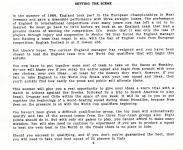

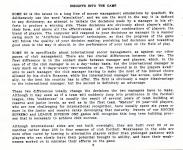
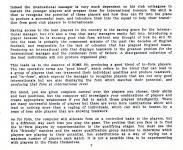


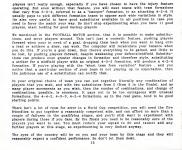


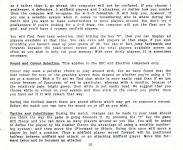

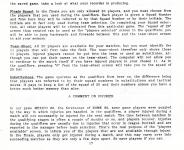
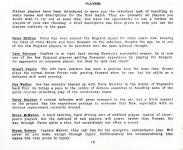

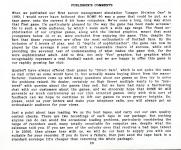




Publisher's Comments
When we published out first soccer management simulation LEAGUE DIVISION ONE in 1983, I would never have believed that ROME 90 was a game that could be put, as a tape game, onto the current 8 bit home computers. We’ve come a long, long way since that first game. I’m particularly pleased by the way the game has been made accessible to such a wide audience, by which I mean such a wide age range. The fixed sophistication of our original games, along with the limited graphics, meant that most youngsters below 12 or so, were excluded from enjoying the game. This, despite the fact that these youngsters are often the most enthusiastic of football fans. By the inclusion of 5 levels of play, and 12 “depths of sophistication”, the game can now be played by the average 8-year old with a reasonable chance of success, while still providing for the severest test of understanding of what makes the game tick, for the most sophisticated adult. Add to this not only “fun” graphics but graphics which recognisably represent a real football match, and we are happy to offer this game to our rapidly growing fan club.
QualSoft have always offered their games by “Direct Sale”, which is not quite the same as mail order as some would have it, but actually means buying direct from the manufacturer. Customers come up with many questions about our games as they try to solve the problems they raise. No dealer, and certainly no High Street multiple, wants to be “pestered” with queries about the games they sell. But we have had many a fascinating chat with our customers about our games, and we sincerely hope that ROME 90 will generate as much controversy as our club-oriented games. Only with this sort of feedback can we hope to continue to lift our games to even greater heights. So, please, send us your letters and make your telephone calls – you will always get an enthusiastic audience for your views.
Just a point about tape loading. We use the best tapes, and carry out our own quality control checks. There are two recordings of each tape in our package. But nothing anyone can do can avoid the occasional loading problems, particularly considering the range of recorders used, many totally unsuitable for computer use (despite what the salesman told you). If you are one of the unlucky ones that receives a bad tape (about 1 in 2000) then please bear with us and we will do our best to supply you with one suitable for your recorder. If you do have a failure, then just send the tape back in a standard envelope (It's cheaper than returning the whole package!).